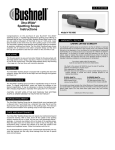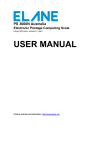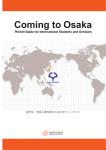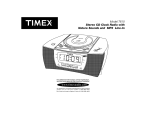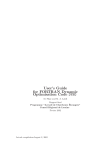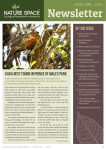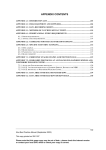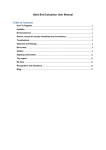Download user manual he pukapuka ako
Transcript
user manual he pukapuka ako Getting started with the application For us and our children after us 2 Te Pöhä o te Tïtï application user manual | contents About Te Pöhä o te Tïtï Who is involved4 What is it for?5 Approval and privacy5 Technical requirements5 Where we get our information from 6 About the model6 Getting started The Home page7 Setting up the Manu and Whänau info 8 Using the Birder Diary10 Running the Population Model 12 Using the Storehouse section 14 Back-up What to do with your records after the season 15 Appendices Monitoring Your Manu articles from Tïtï Times 14 and 16 16 Explanation of the population modelling 19 3 Te Pöhä o te Tïtï application user manual | About Te Pöhä o te Tïtï Who is involved Team Kaimahi Corey Bragg Project coordinator and community liaison, Kä Rakahau o Te Ao Türoa: Centre for Sustainability – Agriculture, Food, Energy, Environment, University of Otago The advisory group consist of members of the Rakiura Tïtï Committee and the Rakiura Tïtï Islands Administering Body: Chris Jones Mathematical modelling, Manaaki Whenua – Landcare Research Cathy Attfield, Margaret Bragg, Ron Bull, Stewart Bull, Barry Clearwater, Robert Coote, Gloria Davis, Jane Davis, Tane Davis, Anthony Fowler, Philip Gilligan, Lesley Rewi, Irene Schroder, Michael Skerrett, Gail Thompson, Riki Topi, and Morry Trow. Julian Moller Development, Massive Media (The above list excludes the newly appointed committee members from the February 2012 permit day hui) Alex Gilks Design, Chopchop Design Jamie Newman Scientific advice and research design, Weka Works Ltd. Henrik Moller Scientific advice and research design, Kä Rakahau o Te Ao Türoa: Centre for Sustainability – Agriculture, Food, Energy, Environment, University of Otago 4 Research directors Photo courtesy of Darren Scott Funding This resource would not have been possible without the support of Ngä Pae o Te Märamatanga. Special thanks to project managers Donna Gardiner and Marilyn Brewin. Te Pöhä o te Tïtï application user manual | About Te Pöhä o te Tïtï What is it for? Approval and privacy This software application has been designed to guide sustainable muttonbirding practises on your manu, ensuring that tïtï remain plentiful for the future generations of Rakiura Mäori. The application will be approved by the Rakiura Tïtï Islands Administering Body (RTIAB) and the Rakiura Tïtï Committee (RTC). Any information you enter into this package (eg. details about your manu, whänau, and harvesting) remains yours alone. It is completely private and confidential, and we will not be collecting, sharing or publishing any of this information. You can enter details about your whänau and manu using the diary section to record and summarise your catch records for each day, month, or season. You can also use this diary section to check on tide times, sunrise, sunset and phases of the moon, as well as keeping notes you want about any relevant daily occurrences on your island. The storeroom section allows you to record the number of buckets & pöhä, and other information about the quality and size of your birds. The population model section allows you to see how the tïtï numbers on your own manu may respond to different levels of harvest. This modelling section is intended to provide a more relevant picture of what may happen on your manu compared to the predictions made for the overall tïtï population by the Tïtï Research Project. We hope that the application will help you make the best decisions for your manu. It can provide a valuable scientific and cultural record of your harvest, as well as being a fun forum and involving experience for birding whänau. Technical requirements Te Pöhä o te Tïtï does not work online, like a website; this is because the tïtï islands don’t have internet available on them. You can run this application on any modern Windows computer. Hopefully this is the most accessible way for the highest number of people to be able to use the application on their manu, and share with other muttonbirders. You are welcome to distribute a copy of this package to anyone who you think may like to try it. Photo courtesy of Jamie Newman 5 Te Pöhä o te Tïtï application user manual | About Te Pöhä o te Tïtï Where we got our information from The tïtï population model in this application is based on the scientific findings of the Kia Mau Te Tïtï Mo Ake Tönu Atu research programme. This project, which ran for more than 14 years, was a collaboration between the Rakiura Mäori muttonbirding community and researchers at the University of Otago. The project would not have been possible without the work, resources, and dedication of many birders, staff and students from the university, the generous funding organisations, countless volunteers, as well as numerous other contractors and community groups. Photo courtesy of Jamie Newman 6 About the population model The mathematical model in this application creates a ‘virtual tïtï population’ of just the birds on your manu, in the computer. The model starts with a population of chicks, young birds (juveniles) and adults in the current year (we organise the birds by their age – much like classes in a school). Next we make this population step forward in time for 50 years, allowing all the birds to get older year by year, but also letting some die and others join in via breeding. All of these steps are based on the best information we have about tïtï breeding and biology. This model can be run again and again, allowing for the uncertainty we have around important steps (such as how likely it is for an adult bird to die each year). This particular model runs a thousand times – we then average these runs to present the graphs and tables you see in this package (see page 13). Te Pöhä o te Tïtï application user manual | Getting started Home Käika Sound Turn the sound on and off here. Export your data Use this at the end of the season, or if you are changing computers. Birder diary Rätaka This is where you record your catch, and make notes for the day. Go to page 15. See page 10. Population model Te rahi o te kähui tïtï Use this to check the sustainability of muttonbirding on your manu. Manu and whänau This is where you put in the main info about your manu, and the people birding with you. Go to page 8. Read more on page 12. Storehouse Whata kai Use this section each time you have finished cutting up and packing your birds. You’ll need to create a new record for each batch. See page 14. 7 Te Pöhä o te Tïtï application user manual | Getting started back home Manu and whänau Here is the link back to the Home screen. Island and manu Choose your island from the drop-down menu, and type in the name of your manu. YOUR MANU NAME Area, burrow density and occupancy Add a new person approximate area (in square metres) If you know these numbers, or have good estimates, enter them in here. This is where you create a new birder. See the next page. Info tips You can hover over these with your mouse pointer for descriptions Weka Click this button to show whether or not weka are removed from your manu. HINT: If you have weka on your manu, see what your tïtï chick numbers could look like with weka eradicated. Tides This tidal data is provided by Land Information New Zealand (LINZ). By default, it shows the ‘standard port’ of Bluff. Choose your nearest location from this drop-down menu of ‘secondary locations’. This will give you tide times in the birder diary, which you use on a day-to-day basis. Tide times have been automatically adjusted for daylight savings. 8 LINZ and the creators of this application accept no responsibility for any damages that result from any errors in this information. Burrow density is how many tïtï burrows (entrances) there are per square metre of ground. Occupancy is entered as the proportion (0 = none, 1.0 = all) of burrows which have chicks in them. Burrow density typically ranges from 0.19 to 0.57 on the Tïtï Islands. The average is 0.41. For more information on how to calculate this value, see page 18. For more information on how to calculate this value, see page 18. Te Pöhä o te Tïtï application user manual | Getting started Manu and whänau > Birder profile Create birder profiles Enter the name, birthday, role and experience of each person who is birding on your manu this season. Save when you have finished creating or editing the birder profile. 9 Te Pöhä o te Tïtï application user manual | Birder diary Rätaka > day view to month view to see the total catch for the month, and key dates in the month. See more on next page. Type notes here Record your catch You might like to use this area to record the weather, observations on your manu, and events that take place on the tïtï islands. Enter your catch for this date, and the amount of time you were hunting for. These values are automatically combined to generate the monthly and seasonal totals. The duration is the time spent by all catchers – this is vital for knowing how much effort it takes to catch each bird (catch per unit effort). See page 16 of the Appendices section, for the ‘Rules to make the numbers work for you’. Sun, moon and tidal data is provided by Land Information New Zealand (LINZ). Tide times have been corrected for the port shown here. You can change your port in the Manu and Whänau section. All times have been automatically adjusted for daylight savings. LINZ and the creators of this application accept no responsibility for any damages that result from any errors in this information. 10 Te Pöhä o te Tïtï application user manual | Getting started Birder diary Rätaka > month view Käi Tahu months of the year Today shows as a lightbrown coloured square in the month view. Click on any day’s square to enter info for that day. Tally for month Key dates These monthly totals are automatically calculated from your daily harvest tallies. The month view shows you the key dates for the birding season. You enter a daily harvest tally by clicking on a day of the month. Both the month and day views will also display the birthdays of the birders whose profiles you have created. You can override the calculation of these monthly totals with a value of yoru own, if you don’t want to enter daily tallies. Moon phases also show in the month view as these little icons. 11 Te Pöhä o te Tïtï application user manual | Getting started Population model Te rahi o te kähui tïtï > Visual mode Click here to see the graph Under the ‘Your manu’ tab, the population model will use the actual tïtï catch numbers that you have already been recording. Under the ‘Custom entry’ tab, you can type in some numbers to see a different future scenario for the tïtï population on your manu. There is an optional ‘Target harvest’ field, so you can plug in a number here if you have a target for the tïtï catch this season. The Run model button will use your numbers to play the animation, showing the future changes in population on your manu. The timeline shows the progress across the 50 years that the model is predicting. The play button lets you play the animation again. The animation shows the numbers of buckets and pöhä-tïtï in the whare increasing or decreasing based on the numbers being used. 12 Te Pöhä o te Tïtï application user manual | Getting started Population model Te rahi o te kähui tïtï > Graph mode Hover over a part of the lines to see the specific numbers from the population model shown along the top. This ‘population meter’ automatically pops up to help give you fast and clear feedback about the results of the population model. The animation and graph results can be pretty subtle! The orange line shows total predicted tïtï population. This line can be turned on and off using the button along the top. The green line shows the predicted number of chicks. You can close this piece by clicking the green arrow. The blue line shows the harvest. 13 Te Pöhä o te Tïtï application user manual | Getting started Storehouse Whata kai ‘Batches’ These are the occasions during the season when you have completed cutting up and packing your birds into buckets or pöhä. You can look back at past seasons using this drop-down menu. Add a new batch each time you package some birds. You can remove a batch here Enter the grade of birds here, using whatever grading system you use (eg. A or B birds). 14 This shows the total number of birds you have caught and entered into the diary section this season (nanao and rama combined). Te Pöhä o te Tïtï application user manual | Back-up What to do with your records after the season This is the first version, and we hope to make improvements! Why back up? Sometime after the season, you may be sent a link to an updated version of the package. Hopefully we have your email address. If not, could you please send it Corey Bragg: In case you lose or break your computer! It happens. Also, all computers die eventually. And getting things from dead or wiped computers, called ‘data retrieval’ can be painful and costly, and isn’t guaranteed to work. [email protected] (03) 479 8059 Export your data After the season, make sure your birding data is secure. Use the ‘export data’ button on the home screen. This will create a file on your desktop which you should back up for your future reference. Then, it’s good if you can back up this file, that is, make a copy of it. An easy and pretty reliable method is to copy your data file to a cheap device like a ‘USB stick’ (it is also called a ‘pen drive’). Then keep the device in a safe place. look for this icon on your desktop 15 Kia ora whänau, We hope you enjoy the first version of Te Pöha o Te Tïtï. Before each season, we’ll be updating the information for your calendar (e.g. tide predictions, moon, sunrise and sunset). So keep an eye out for any updates. Remember - this is a resource for your whänau, and it is completely private and confidential. Also, if you have any new ideas, improvements on the existing app, or features you’d like to see added to the next version, please get in touch. Email questions or feedback to [email protected] We wish you all the best for the up and coming tïtï season. Ngä mihi – Many thanks, Project Co-ordinator Corey Bragg 16 Te Pöhä o te Tïtï application user manual | Appendices Article from Tïtï Times 14, November 2004 Historical harvest records: long-term benchmarks Many birders already keep their own records, and some have gifted these historical figures to the research team. Such whänau will receive their own confidential report on long-term trends, good and bad seasons, and changing patterns of birding on their own manu. Let us know if you want a confidential analysis done on your own records. While the existing records are valuable and potentially hold the key to our main puzzle (what is causing the recent declines in the tïtï?), much more information could be gained from them if a few simple rules are followed. See the box over the page for suggestions of what to do. Two minutes a day measuring harvest rates: a finger on the pulse of future tïtï populations? Most birders already record the catch (tally) for each day and night of the season, but many have not kept accurate records of the ‘catch effort’ to match them. If you also record the number of people out catching (more hands make light work) and the time spent gathering the birds, we can measure the harvest rate (birds caught per person per hour). It is the speed with which you can gather the birds that will be the best guide to bird numbers. Harvest speed is a measure of catch-per-unit effort (where effort is measured as time). For example, about the same daily tally may have been gathered over the past three decades from your manu, but the birds may have been going down if you were gradually adding more hours of work to get your daily target. Alternatively, if the bird numbers were trending upwards you may have been getting your tally by early afternoon in recent years, whereas it may have taken till late afternoon in the early 1970s. If your tallies are trending down, it may be that your strong teenagers have left to set up their own workhouse and separate tallies. • Writing down exactly when you went out to harvest and when you got back to the workhouse, and how many people were helping allows us to tease out these alternative explanations to get at the underlying trends in the birds themselves. • Recording the weather helps to ‘factor-out’ the effect of year-to-year variations and get to the underlying trends more quickly. For example, if the nanao had a whole string of wet days, catch may be down that year. A statistical analysis of the tallies and weather records can predict what each year would have yielded had the weather been perfect all season long. The same goes for wind and moonlight during the rama. The size of the chicks also seems to affect the harvest rate for a given season. Rules to make the numbers work for you 1. Keep a separate record for each day of birding. 2. Record number of chicks captured in each ‘hunt‘ (a ‘hunt’ is a session of gathering away from your whare). 3. Record the time you left and returned to the workhouse to the nearest 5 minutes. Only include the time gathering - do not include the time processing (plucking, cutting up etc.). 4. Record rain, wind strength and moonlight for the time you went hunting. 5. Write down exactly who went out to catch the birds that day - if some in your party keep a different routine, keep a second record sheet for that person. Just include people catching, not those helping process chicks in the workhouse. 6. Note whether the hunt was a nanao, evening torch or morning torch. Keep a separate record (tally, time in/out, names of gatherers, weather etc) for an evening and morning torch if you do both on the same night. 7. At the end of the season, record the number of buckets with 18, 19, 20 chicks etc. You can work out the average size of the chicks for the season from these totals. 8. Keep a note of any unusual events, or major habitat changes, changes in where you bird, arrival of other birders on your ground etc. to help piece the overall patterns together. 17 Te Pöhä o te Tïtï application user manual | Appendices Monitoring your manu continued • Keeping a record of the number of buckets of 118, 118, 180 etc. chicks can be used to measure the average size of the chicks for the year. capacity building’ into the request to FRST for funding the last five years of the project. The next Tïtï Times (number 15) will feature details on burrow counting, some of the potential problems and fish-hooks in the use of harvest rates for monitoring bird abundance. Provided we work within the limits of the method, we reckon it can still give a reliable index of bird trends. The most important thing is that filling in the form will take two minutes every day of the season – not much hassle for a busy and tired birder – and a hell of a lot cheaper than hiring a research team to roll around for hours in the peat poking a cumbersome burrowscope down the holes (see Tïtï Times 2 for a description of the burrowscope, our most hated instrument of field worker torture). Hanging in there for your mokopuna: ten years of counting will be needed before trends could emerge Overall manu monitoring Aside from the changes in bird numbers, you may like to monitor habitat condition and vegetation, unusual events etc. Taking regular photos from the same ‘photo points’ could really help here. Keeping a record of the ground worked could be important if new birders are arriving or manu boundaries shift. Analysis: making sense of the numbers later Collecting the numbers is just the first step. A statistical analysis to test for trends is a reasonably specialised job. Your community’s request to build up your own Rakiura Mäori science unit could become crucial here. The hui in July 2002 asked the research team to identify funding sources to get such a team together. We have made a start by applying for Command oil spill reparation money from America and including Rakiura Mäori ‘science 18 Trends can only be detected after ten or more years of counting. The more years you can persist, the better the information. Remember, your bird is long-lived and reproduces slowly. The slow population turn over makes monitoring a life- time commitment – it is part of the long-term vision needed to keep the tïtï forever! - Henrik Moller Article from Tïtï Times 16, December 2005 Counting holes: the next step up in commitment to monitoring Some of you may want to invest a day or two of extra effort into monitoring your manu by counting holes. A count of holes in a series of staked out squares (“plots”) or along lines (“transects”) would be helpful. Squares of about 5 m by 5 m are ideal, or you could run a line out between a start and end stake about 10 - 15 m apart and then count the number of holes 1 m either side of the central line. The key thing is consistency. It is really important to go back year after year to the very same plots or transects. Otherwise you will only measure differences from one part of your manu to the next rather than changes to the manu over the years. It is best to mark your plots or lines using 1m long aluminum or steel stakes. Take special care to count both recently closed holes and open ones, and to use a standard rule for deciding if the hole falls just within or just outside the transect or plot (see the diagram below). Run a string along the line or around the outside of the plot so you can accurately decide whether the hole is in or just outside the count zone. Write down the size of the plot or length of the line and record the exact number of holes there. Keep the records in a safe place and record any major problems or disturbances (lost stakes, windfalls, etc) that could have affected the count. A photo taken from exactly the same spot, like the start stake of the transect, or SW corner of the plot is also useful. The historical photos can really help interpretation later. Te Pöhä o te Tïtï application user manual | Appendices Monitoring your manu continued Having established your plots or transects, it is important that you do not treat them any differently to any other part of your manu when harvesting. The change in hole counts on your plots should be typical of what is happening everywhere, so it is best to just ignore whether there is a plot or line nearby as you go about your normal harvesting. The number of plots or lines used depends on how much time you want to put into this monitoring. The research team tries to establish at least 12 transects on each manu, and we take care to spread them randomly around the manu so that they measure roughly what is going on everywhere (See Tïtï Times 8 for all these conventions). If you just count holes in one or two places, they could be some of the few spots on the manu that are different from the rest, so you would be misled. The more plots you put in, and the wider they are spread, the more reliable your results will be for your mokopuna. Also try to make sure that some of them are in closed-in ground and others are in the open manu. Some of you hosted our research team on your manu, so you already have stakes placed to mark transects. We are not sure who will be back to count the holes there in future (hopefully your own Taiaio Unit), or when they will come. A recount is scheduled for around 7 years time as part of the rat eradication monitoring. In the meantime you might like to count the holes every second year. If so, let us know and we’ll send you the details and map to help. Measuring changes in burrow occupancy: the ultimate commitment It could be that the number of holes doesn’t change much, but the proportion of them with chicks does decline or increase. We use the burrowscope to check Harvest rates are a pretty rough and ready index of bird trends because Mätauranga is used by the birders to alter where they go on their manu according to the wind, rain or moon that night. Many experienced birders also have a “quick look” before deciding to either take a well earned rest for the night or set out for a big hunt. So the birders don’t ‘sample’ birds at random places or times in the way a scientist would to estimate the number of chicks out there. This makes the harvest rate measures a rather blunt tool for tracking changes in bird numbers. But the superb long run of tallies and ease of measuring the harvest rate make your records incredibly valuable as long as they are carefully interpreted within the limits of what they can show. Two papers by the research this out, but those of you nanaoing could do you own index simply by keeping a count of the number of holes you prospect to get your tally of chicks. If you recorded the number of chicks removed from say the first 200-300 holes you try out every year, you could get an index of occupancy. Obviously you will miss some, just as the centre team explain some of these opportunities and limitations for monitoring through harvest rate: Moller, H., F. Berkes, P. O. Lyver, and M. Kislalioglu. 2004. Combining science and traditional ecological knowledge: monitoring populations for co- management. Ecology and Society 9(3): 2. Newman, J., and H. Moller. Use of Mätauranga (Mäori Traditional Knowledge) and science to guide a seabird harvest: Getting the best of both worlds? In Kishigami, N. and J.M. Savelle, editors. Indigenous Use and Management of Marine Resources. Senri Ethnological Studies No. 67: 303321. National Museum of Ethnology, Osaka. (2005) Let us know if you want a copy. burrowscope does, but doing the same sort of sample each year will still give a measure of whether the trend is for fewer or more birds in the available holes. - Henrik Moller centre centre include this one exclude this one centre of plot burrow entrance include this one The rule to decide whether or not an entrance hole is within or outside the transect or circular plot. 19 Te Pöhä o te Tïtï application user manual | Appendices Developing the harvest model Article for birders by Chris Jones from Landcare Research Manaaki Whenua A model is a simplified version of reality. When we talk about a model of a population of birds, for example, what we mean is some simple way of representing what we believe to be the key parts of the population, how that population changes over time and the key factors that drive that change. A “population” of anything: people, polar bears, deer, fish, or titi is made up of individuals that we can put into classes according to their age or sex or some other category. If we add up the numbers in each group, we get a total for the whole population. That number will change from year to year depending on the number of individuals that are born, die, join or leave the population. If we can estimate, on average, what these numbers are, we can then estimate how big the population will be from year to year. If we have enough information, we can do this in a very detailed way, by looking at how each group in the population changes over time. For a titi population, for example, by looking at information from banding records and from checks of eggs and chicks down burrows during the breeding season, we can estimate how many adults are likely to survive from year to year and how many eggs are likely to result in chicks that are either available for harvest, or fledge to return as 20 Adults can survive and some will breed. Others will skip breeding or die. adults Juvs can survive and mature into adults. Some will not make it. each year chicks juveniles Chicks can survive to become juvs or be killed and eaten by weka or people. Te Pöhä o te Tïtï application user manual | Appendices Developing the harvest model continued new breeders in a few years’ time. Sometimes we don’t have the right information about the species that we are interested in, so we use information from the closest related species that we can find out about. Once we have estimates of how big a population is, and what the survival and breeding success rates are, we can link these together using mathematics to predict what the population size, or the number of eggs produced, or chicks available for harvest, will be next year. Then we use the same mathematics on next year’s population to predict numbers for the following year, and so on. This allows us to predict what will happen to that population over time, but, there are a couple of really important things to remember about models. The first is that they are just models, not reality. They represent the best knowledge that we have about something, and the better that knowledge, the more reliable we would expect our predictions to be. Perhaps the best way to use them is to compare the predictions from one set of circumstances with those from another, for example, by asking what the effects on the population are likely to be by removing predators or not, or by doubling harvest versus no change, etc. This is the kaupapa with which we have developed the titi harvest model. and proportion of those burrows that are occupied by chicks. With this estimate of the number of breeding pairs, we then work out how many birds should be in each age group from 1-year-olds up to a group containing all birds of 14 years and older. Each age group is affected by the survival rate for that age group to give the number of birds in the next age group in the next year, and so-on. All birds of 4 years old and older can breed, but the chances of a bird breeding increases with age up to a maximum from age 9 onwards. All the eggs produced by the different age groups are added together to give a total number of eggs. We then apply our breeding success rate to the number of eggs to get the number of chicks. One of three things can then happen: if weka are present, the model takes away some chicks to represent losses due to predation; the remaining chicks are then subject to harvest, with the number actually removed depending on the amount of effort (harvesters, experience levels, number of days, nanao or rama) put in. The remaining chicks then fledge and the model applies a survival rate to these to estimate the number of 1-year-olds next year, and so-on, again. - Chris Jones Essentially, the titi breeding population on a manu is estimated from the manu size, burrow density 21






















